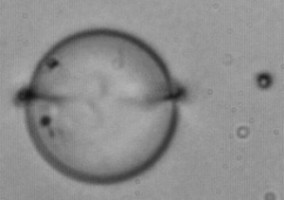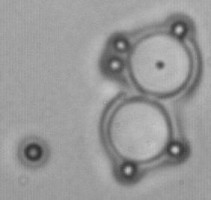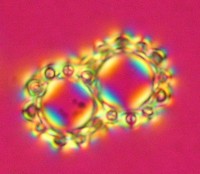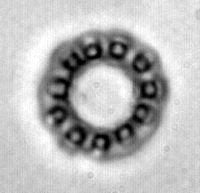Hierarchical self-assembly of nematic colloidal superstructures
| Mixtures of different sizes and shapes of colloidal particles in the nematic liquid crystal are interesting not only from the fundamental point of view, but also for possible applications in photonics. We are interested in whether nematic colloids could be self-organized in structures with optical properties of metamaterials. Metamaterials are artificially-made micro- and nano-structures that exhibit negative index of refraction and could be used as superlenses (no difraction limit of the resolution) and cloaking materials to make objects optically invisible.
We show that colloidal superstructures resembling split-ring resonators could be assembled in mixtures of large and small colloidal particles dispersed in a nematic liquid crystal. Using elastic interaction of small colloidal particles with the disclination lines we succeed to demonstrate how one can decorate with small particles a topological matrix of defect rings and loops formed by an array of large colloidal particles. |
| Furthermore, we have chosen the »figure of eight« entangled pair to create a more sophisticated scaffold of decorated defect lines. Here, a perpendicular alignment of the liquid crystal in the measuring cell was chosen, so that the Saturn rings now appear as dark circles in the plane of image, whereas an entangled defect loop is a thin dark line encircling both colloidal particles. |
| Spatial organization of smaller colloidal particles, assembled in the defect ring of the figure eight is shown in more detail below. The deformation of the director field around a superstructure, formed by smaller and larger colloidal particles, is clearly illustrated by the interference colors. |
| The observed colloidal superstructures are extremely interesting for application in metamaterials. Providing that the small particles are made of conductive material, such a structure could function as a distributed split ring resonator. An estimate shows that for a 5 µm diameter of the colloidal ring and 50 nm diameter small particles, the resonant frequency of the distributed resonant circuit is at the order of 15 THz, corresponding to the wavelength of 12 µm. |
| ŠKARABOT, Miha, RAVNIK, Miha, ŽUMER, Slobodan, TKALEC, Uroš, POBERAJ, Igor, BABIČ, Dušan, MUŠEVIČ, Igor. Hierarchical self-assembly of nematic colloidal superstructures. Phys. rev., E Stat. nonlinear soft matter phys. (Print), 2008, vol. 77, no. 6, 1061706-1-061706-4. |






